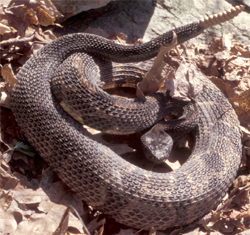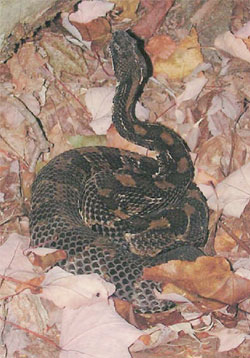Crotalus horridus
Timber Rattlesnake
Identification
The Timber Rattlesnake has black W-shaped cross bands on a tan background. The rattle on the end of the tail is a yellowish tan color. They may have a yellow head, in which case they generally have a brightly patterned body, or they may have a black head, in which case they have a darker patterned body.
The rattlesnake is a thick snake usually 2-4 feet in length (the longest documented in Vermont is 54 inches), with heavily keeled scales.
This is Vermont’s only venomous snake. It is not at all aggressive but it should not be handled.
Range/Habitat
They inhabit rock slides, ledges, and nearby woodlands.
Before You Report a Rattlesnake
One hundred percent of the Rattlesnake reports that we have checked up on, outside of Western Rutland County, were actually Milksnakes. Milksnakes have an eye-catching pattern, and they rattle, coil, and strike. This behavior is a bluff, but it convinces many people that they are seeing Rattlesnakes when they really are looking at a Milksnake. Instead of a shaking tail, a rattling sound, or a striking pattern, look for the solid black tail, solid black or yellow head, and a large and obvious segmented, yellowish brown rattle at the end of the tail. If you see a visually striking pattern and hear a rattle or see a snake shaking its tail, it is probably a Milksnake. If you see a segmented rattle at the end of a black tail, it is a rattlesnake.
For more information on this frequently made mistake please read:
Page, Candace. 2009. Sightings of Milksnakes, Rattlesnake Mimics, Shake Residents. Burlington Free Press (July 9, 2009), 1B-2B. (Online title: Harmless snake scares homeowners). Available as PDFs: Printed from Free Press site, text-only PDF and scanned from hardcopy, PDF with pictures. (PDF reprints of copyrighted material used with permission from author.)
Status
This species has a state natural heritage rank of S1 (rare). The Timber Rattlesnake has been designated a Species of Greatest Conservation Need (high priority) in Vermont’s Wildlife Action Plan and is endangered in Vermont. Please report all sightings of this species in Vermont. Take photos if possible. Even historic sighting information is useful.
More Info
- Crotalus horridus at the Animal Diversity website
- Crotalus horridus at the CARCNET website
- Crotalus horridus in the Vermont Agency of Natural Resources’ Wildlife Action Plan (PDF)
- Crotalus horridus at the Snakes of Massachusetts website
Species summary written by Kaile Burgess.
In the Media
__________. 2011. Groups join forces to save Vermont rattlesnakes. Burlington Free Press (April 6, 2011). Available at http://www.burlingtonfreepress.com/article/20110406/NEWS02/110405029/1007/Groups-join-forces-save-Vermont-rattlesnakes (accessed April 16, 2011). Also available as PDFs printed from Free Press site, PDF with pictures or text-only PDF. (PDF reprints of copyrighted material used with permission from author).


